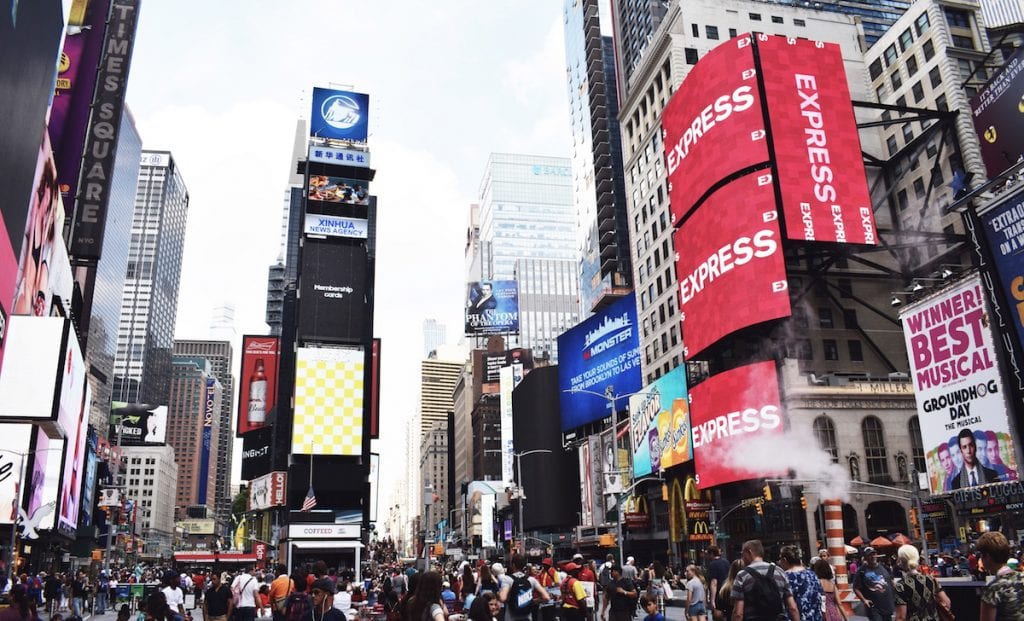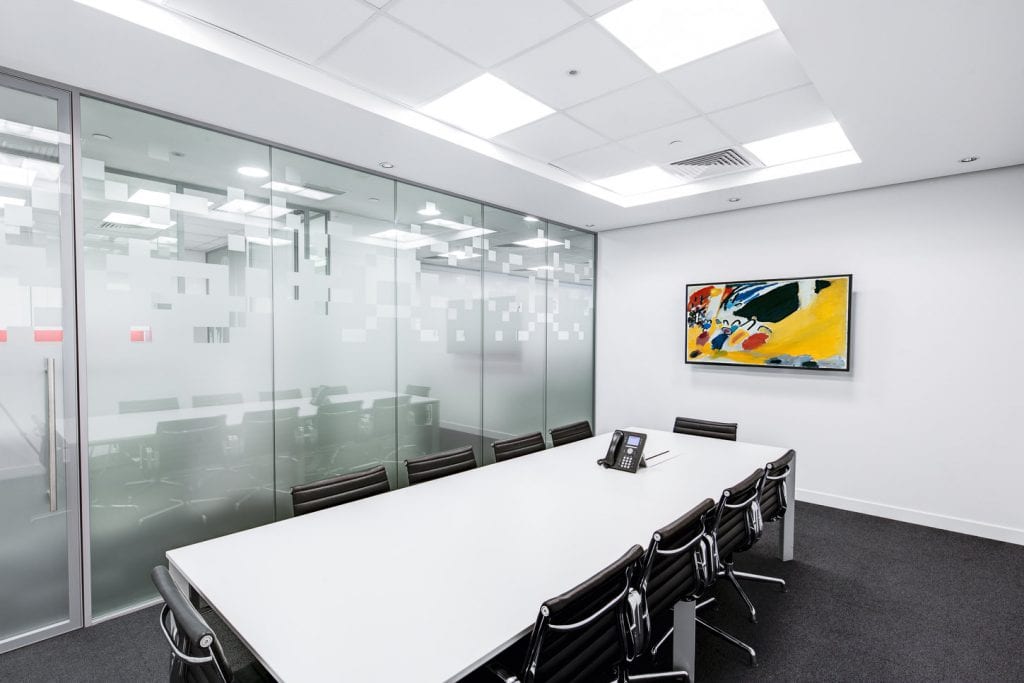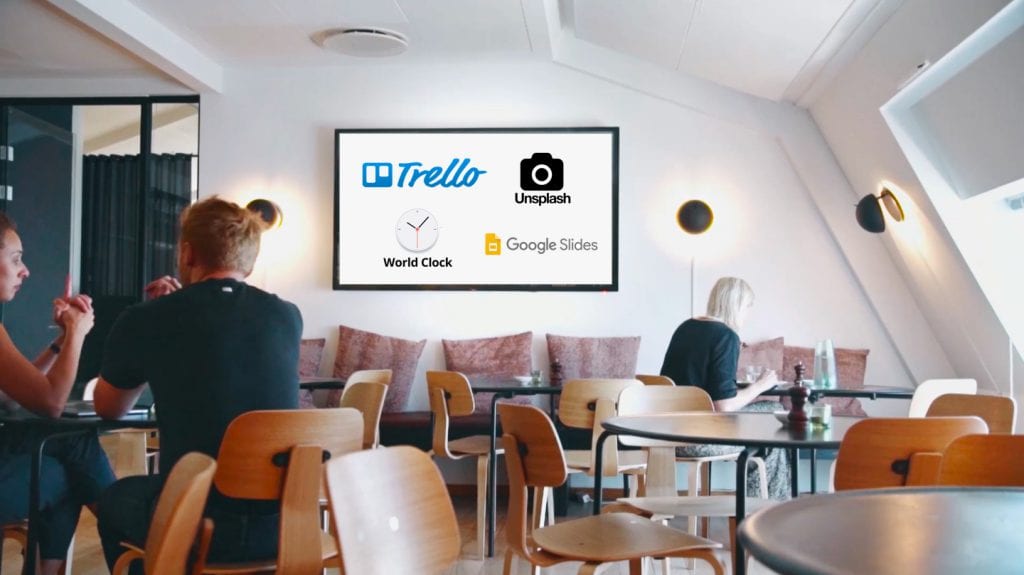
JULY 2ND, 2018
We all know what digital signage is, at least implicitly. Most of us have taken a look at the menu in the drive-through lane at Mickey D’s, or even ordered our greasy goods from a digital kiosk stand. At the airport or train station, we’ve glanced at the departure and arrival times. We’ve seen perceived wait time on passport queues or trafficked highways.
There are countless examples like these, and they are all, in some form, digital signage. It’s everywhere, integrated with many different businesses and needs. In fact, the digital signage industry accounted for 19.6 billion USD in 2016. In 2032, it’s expected to reach more than 32 billion USD. It’s a rapidly growing industry with enormous potential.
As we grow more accustomed to a digitalized world, digital signage assumes a more significant role for enterprises. Workforces distributed across multiple locations benefit from a centrally controlled content distribution platform and old communication tools get replaced by new, smarter technology. That’s what digital signage represents – a solution that delivers timely information.
Airtame focuses on getting the most out of screens and projectors through best in class wireless presentation technology. With our platform-agnostic product, users have previously been able to mirror their screens, stream or set up static content. As our mission to unlock the power of professional displays develops, both the product and our focus is naturally moving in the direction of digital signage. With newly set up applications, users can integrate the Airtame Homescreen with dashboard services, beautiful backgrounds or simple tools like a world clock, inspiring imagery from Unsplash, Google Slides, and Trello boards.
As a term, it’s often connected with the screens themselves, but the screens or the size of them is not what makes digital signage a game-changer for engaging audiences. It’s a sea of possibilities, not just for retailers but all businesses, big and small.
There are endless ways to explore the power of digital signage and how it makes the daily flow of information more interactive, responsive, and user-friendly.
But before we get to the use cases and many interesting ways digital signage can be deployed, let’s try to fit the term into a box.
It can be found in both public and private domains, and we’re already experiencing it in all kinds of environments. Digital signage is in many instances a replacement or an alternative to analog signage. It’s the small changes we’re not paying attention to, like the poster with the schedule by the bus stop that’s been replaced by a screen, or the digital noticeboard at the airport indicating gate and takeoff info.

Even though we don’t always notice it as a marketing tool, digital signage is immensely popular. Because the dynamic content engages an audience better than regular, static messages, the value of deploying it is higher. Up-to-date, relevant content, moving images and changing graphics make sure the message is always on point.
Let’s go back to the menu kiosks we mentioned in the beginning. It’s a touchscreen that allows the consumer to interact, and in this case, place an order. It’s a great example of how digital signage can guide the customer journey. Oftentimes, the customer journey isn’t a part of the decision when people put up digital screens, which is a big loss.
Many think of digital signage as a means to display information around a venue but no more than that. Besides attracting attention however, digital signage allows you to promote or advertise your product or business, provide in-store entertainment, offer a personalized experience or talk directly to the customer, employee or visitor.
One thing that makes many types of digital signage differ from analog signage is the ability to not only display dynamic content but to be interactive as well. In the instances where interactive displays such as touchscreen are used, digital signage becomes even more user-friendly.
It’s cost-efficient and a step in an eco-friendly direction. Imagine a restaurant that rotates menu items as the seasons change or a promotional campaign for which thousands of copies are needed. After the season or the campaign is over, all that paper material is thrown out because it’s no longer relevant. With digital signage, all it takes is an update in the CMS, and the content displayed is again up-to-date.
Signage has been a part of human communication for as long as we know, and now digital signage is taking the marketing industry, office spaces, and public displays by storm.
We went from primitive pointers to customized content with real-time updates – some even GPS-controlled and tailored to each user. The latter sounds very Minority Report, but it’s not even a future scenario.
The technology is here, and chances are you’ve been exposed to it already. To some, it might sound a bit scary, like a scene out of Orwell’s universe, but rather than an ominous Big Brother breathing down your neck, you should look at it as a useful tool with multiple benefits.
Burger King and McDonald’s have been using digital menus for years, and recently, menu kiosks from which you can order your meals have also become available. Both burger chain conglomerates use a digital signage system to repurpose images and menu items and even combine them with trends, targeted ads, and demographics. At Build-A-Bear, kids can put together their plush animals via an interactive touchscreen tool that serves both an advertisement and selection purpose.
Besides retailers and eateries, digital signage makes a difference for common areas that can otherwise be confusing. In hospitals, banks or just the average office space, digital signage provides a clear and consistent message that can direct and inform staff and visitors.
More than that, digital signage can improve productivity at an office by providing easy access to information. Digital signage deployment within workspaces is an often neglected opportunity to communicate directly with staff but can make internal communication more accessible and effective.
An overlooked function in both corporate and educational facilities is to utilize digital signage as an emergency alert system. Digital displays can notify employees and students of emergencies like weather conditions, safety hazards or violent situations. Strategically placed displays will help inform what actions they need to take and how to stay safe.
Digital signage is the most efficient and affordable method for getting a message out, whether it’s a meeting room agenda, communication protocols or inspirational visuals.
To understand where we are today, and where we could end up in the future, let’s go back in time and explore the history of signage.
Intelligent forms of communication have always been part of humanity and with that, we’ve found ways of instructing others. We’ve needed it to warn of danger, help kindred spirits or signal our strength. Thus, signage is nothing new. Dating all the way back to the Paleolithic Age, around 18,000 BC, cave and rock paintings were used not only to offer directions or information but a ritualistic perspective as well.
Ancient Egyptians would cut stone to indicate religious sites or carve out historical events, and their inscriptions with hieroglyphs are some of the first written accounts we’ve come across. The word “sign” is derived from the Latin “signum”, which means mark or token. While the Romans were not the first to use signs, they were the first to introduce a road system, and with the road system proper signage as well.
In 1393, King Richard II passed an act stating that all alehouses must post a sign. Thus, pub and inn signs became a popular advertising statement. Supposedly, the first poster ad in English was placed on a London church door in 1472. When trade and commerce picked up some centuries later, and Gutenberg invented the printing press, communication became even more intricate.
In the mid-1800s, the production of newspapers, flyers, magazines, and catalogs picked up. As often before, communicative means coincided with the evolution of technology, and the same era experienced remarkable inventions such as gas lighting, cars, and electric bulbs. It completely changed the news industry and workspace area because all these new products needed actual advertising. In 1890, the first advertising agency was established.
The Bauhaus Movement, which started at the beginning of the 20th century, pushed signage in the direction of art. Eventually, signage was not only a practical issue but one of aesthetic as well. Design, typography, and color were suddenly an integral part of signage.
As signage evolved, so did technology. In time, they merged. An American car salesman ordered the first ever neon sign in 1929, shortly thereafter making it in high demand. One can only imagine the joy of shop owners as they could finally display specific messages such as “open” or “closed”.

When thinner television models became more affordable in the early 00s, retailers began using them for promotional value – just as they did in the 70s when the VCR hit the market. Flatpanels became a norm in many stores and public spaces, replacing banner ads and paper posters. High-quality ads streaming in-store was an impressive sight, wowing customers and influencing sales.
But the content displayed was still of a more static nature, either a looping ad, still images or simple slideshows.
The display network’s content is managed with software, called Content Management System (CMS). Some only use CMS as a central platform to manage content, whereas others use it to build and create from scratch.
Networking media players to screens took off in the 70s with VCRs (VCRs connected to TVs is not considered digital signage however), and soon thereafter came various digital signage software types.
Yet the software is nothing without the screens on which to display it. As with other types of technology, the evolution of screens has been fast-scaling and incredible. Hardware display screens could be either LCD, LED or even projection, but interactive displays are also on the uprise. As prices went down on flatpanel technology, the impact of the content displayed began to decrease as well. People wanted more storytelling and further innovation to keep them engaged, and that brings us to where we are today.
With screens being an integral part of so many businesses, public spaces, and organizations, it should be something to consider for everyone. It very well could be that someone is not taking full advantage of the options to promote and improve their business because they simply haven’t heard all the benefits. More companies and organizations are allowed to penetrate the market because prices on both hardware and software are plummeting. In short, we are moving away from the typical “Times Square style” digital signage at a rapid pace, and the opportunity for smaller, more cost-effective deployments digital signage is on the rise.

- Internal information: There is a considerable potential in aiding employees, students or visitors on-site. Proper digital signage can convey important news or corporate messages, display real-time health and safety information, meeting room updates or calendar events.
- Public information: If you’ve ever been stuck in traffic and wondering if a different route is more manageable, digital signage could help you out. Traffic information, news items or even directions could help you on your journey.
- Product information: Displaying marketing messaging associated with the product or service can be very helpful to the user. It could be pricing, nutritional value, ingredients, and suggested usage.
- Advertising: Great digital signage advertising can be used to direct the customers’ attention and promote services. With third-party advertising, owners of digital signage boards can give the option to bid for the signage space to promote a product or brand.
- Branding: Tailored brand messaging or illustrative graphics can be used to raise brand awareness.
- Enhancing the customer experience: Whether you’re walking around in a supermarket, airport, museum, zoo, park or any other cultural attraction, digital signage can be used to help aid understanding, provide demonstrations or list perceived wait time.
- Influencing decision-making: Digital signage can be used to increase dwell time at specific items or areas, impulse purchases by displaying marketing messages or persuade customers through discounts or offers.
- Navigation: Dynamic wayfinding through digital signage is upping the game of regular wayfinding. Think interactive roadmaps and footprints that might even be GPS-controlled.
- Digital menus: Being able to change signage easily is very beneficial to many restaurants, eateries or retailers since menu items and products fluctuate throughout the seasons. Digital menu boards would also allow users to reserve a meeting room in an organization or even a table at a restaurant. It could be used to book a resource or for a chance to upsell at the time of purchase.
- Entertainment: This category could fall under several of the others since entertainment can help attract the user’s attention. It could be a native video wall, promotional videos or even mini-games.
But that doesn’t mean school environments should skip on digital signage altogether. By adding informative and interactive screens, education institutions can upgrade the learning experience. Digital signage can certainly be tweaked to fit school information and streamline communication.
Instead of relying on complicated email systems and paper notices, digital signage is an opportunity to keep students up to date with events, news or real-time changes. Because corridors and common areas in schools are often crowded areas, it’s the perfect place to display and share information.
School announcement, image and video content, lunch menus and welcome messages. Students today are used to getting important information from digital displays, therefore making digital signage a perfect solution.
Learning environments call for an effortless solution that’s easy to maintain both in regards to software and hardware. Because content shifts so often, it’s a must to find a solution that can be controlled centrally, preferably even remotely, to take off some of the strain on janitors and IT admins.

Besides using screens for sharing important messages internally, digital signage invites the user in and creates a dialogue. Through interactive displays with touchscreen technology, the audience can search for a specific product or service, look up features or design their customer journey that could unlock rewards, games or extra information.
The incentive behind interactive touchscreen technology is huge because the interaction between user and content becomes more memorable and entertaining instead of informative and narrow. To the user, the interaction is now a simulated two-way conversation rather than an overload of information to digest.
Another kind of live interaction comes from social network integration. Real-time twitter conversations could be displayed to show a political climate or quality of a service, just as selfies or comments could help boost the feeling of dialogue. Social media synced screens can help bring the online brand into the real world and help the consumer feel valued, even courted.
Increased personalization: Interactivity will get even more individualized. Responsive and automated content could be directed from sensors or data flows that improve the point of contact. Real-time updates will be tailored to real-world conditions and the exact consumer in question. We’re already experiencing examples of this with ads that change according to weather such as umbrella ads when it’s raining and ads for sunglasses or outdoor activities when it’s sunny.
Demographics will be used to tailor the user experience. Through open sources or private devices, personal information such as age, preferences, job position, and income may be used to guide users to their specific taste preferences.
Recognition: Sensors, cameras, and voice recognition can be used to aid the user further. With the right amount of accuracy, users can be greeted by name and offered services that suit their needs.
Since sensors will be able to connect with data flows, AI can tailor the digital signage shown and when it should be shown. If you’re browsing the vegetable section in the supermarket, screens can show you recipes that match the vegetables you’re looking at and deals on similar items.
Digital signage and AI: With more accuracy and data processing comes a better understanding of the users. Smart digital signage could even end up replacing human-to-human interactions altogether. It’s already happening in the restaurant industry, but soon other areas of the service industry could follow suit. Corporate offices, banks, hospitals and many other places would most likely benefit from an increase in intelligent digital signage.
Amazon Go has already introduced a shopping experience with no personnel, lines or checkout. Via advanced technology and a smart app, you will be shown the best product for you, similar products you might like or discounts applied to the suggested items. As you take the items and leave the store, you automatically pay for them via the app.
As we get more and more comfortable with AI solutions that target us, a more personalized experience probably isn’t far off. Facial recognition and content triggered by our preferences is something we might be able to experience very soon.
And no great product truly lives without great advertising, so sketches, drawings, and soon photographs too would aid us in choosing the right products. With the boom of the internet and computers, we were suddenly even more interlinked, and we started to understand the power of commercial display and engagement reach.
-
1. Sell more products
2. Increase productivity (in employees and students)
Digital signage doesn’t have to be overly complicated or difficult to manage, and since it’s more affordable and accessible than ever, even smaller organizations with limited staff or resources can take advantage of it too.
With each new development in the field, the bar is raised, producing more stable, secure and versatile solutions. Open-source technology and platform-agnostic solutions mean that more and more businesses are able to set up digital signage efforts.
The audience has been given much more power than the one-way flow of information from before. They’re now encouraged to explore an experience tailored to their specific needs from a device of their choosing. It’s a golden opportunity to communicate directly with them, collect valuable information or provide an even better service.
Cost-efficient: Change and update content at no additional cost.
Informative: Inform your target audience with relevant content. Use it to relay internal messages or to communicate with external parties such as visitors, clients or customers.
Effective: Control your content from a central platform and update it with no more than a few clicks, no matter where your screens are located.
Engaging: Engage your audience via games, videos or interactive content to create a memorable and entertaining experience.
Branding: Digital signage allows you to send a relevant message that aligns company values or branding ideas and use it to add promotional value.
When employees are in sync with the organization’s mission, they become more productive. They waste less time if company information is shared with them directly and if the message is consistent and available.
Airtame is not only a screen sharing device, it’s also a package of innovative solutions for digital signage and artful content that are easy to set up and use. In Airtame Cloud, where you manage and monitor your devices, we offer several applications and ways to turn your screens into digital signage.
One of the simplest forms of digital signage with Airtame is to set a custom background. Show stock images, your company logo or pretty images. Another form is to show a specific URL or rotate between several. You can create simple slideshows or loop between multiple URLs to rotate content. This option has been deployed successfully at Hult International Business School.
Trello: Trello is no stranger to corporate culture. Those who already use Trello know how appealing it is to see plans, projects, and ideas visualized and neatly structured. For those unfamiliar with Trello, it’s a project management tool that keeps track of joint tasks. The Airtame integration means you can set up sprint boards and shared projects. You can choose to show several columns on each screen or spread them across several.
Unsplash: Artful content is known to increase productivity and create a more positive work environment. The online photography haven Unsplash is a wonderland of free, beautiful images. Choose between thousands of photos and pick your favorites to display on Airtame when no one is streaming to it.

Google Slides: Google Slides is the king of online presentations. Several people may work on the same slideshow simultaneously, which makes editing a breeze. Digital signage on Airtame with Google Slides is not just presentations though. You can show updated calendars, lunch menus, agendas and personalized content. When you make changes to the slideshow, your displayed content is automatically updated as well.
We’re constantly working on upgrading the Airtame experience, and with the aforementioned app integrations, users will now be one step closer to communication smarter and more effectively.

